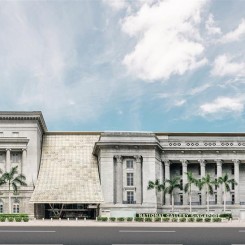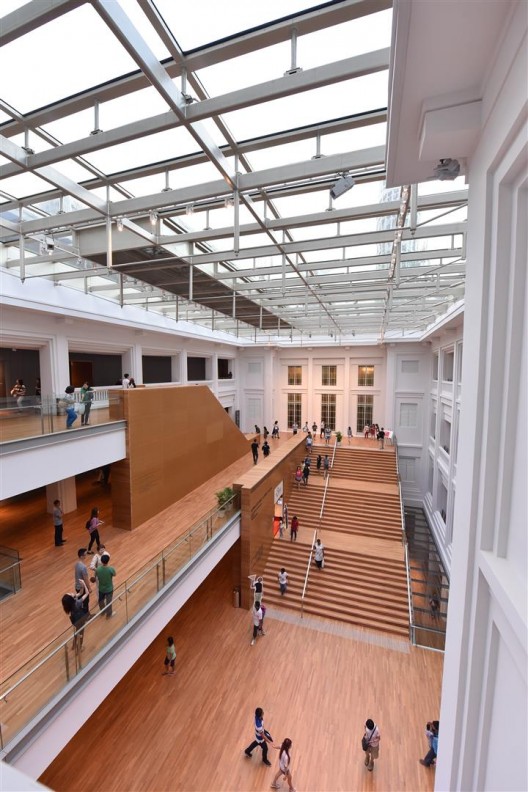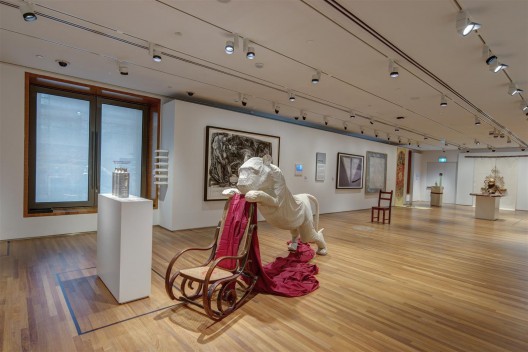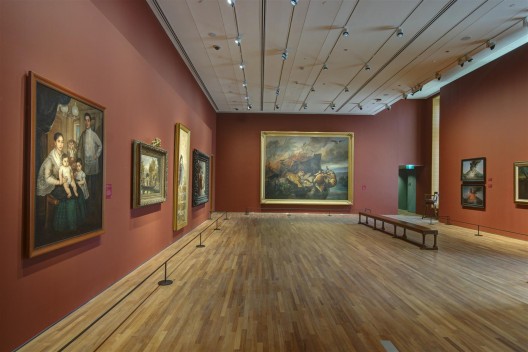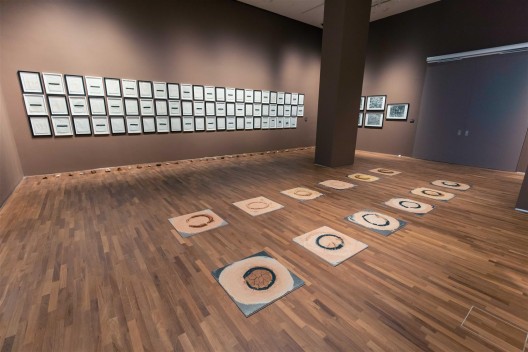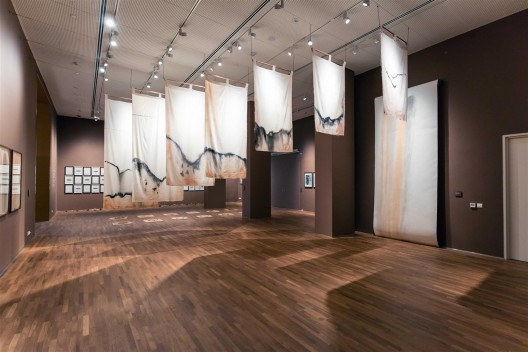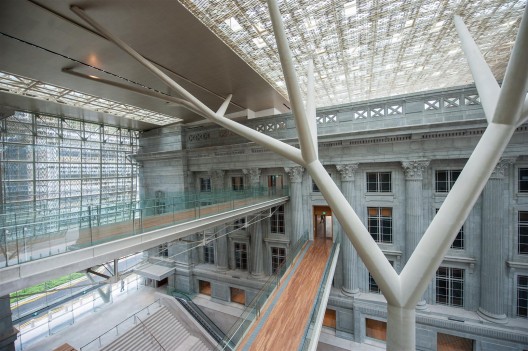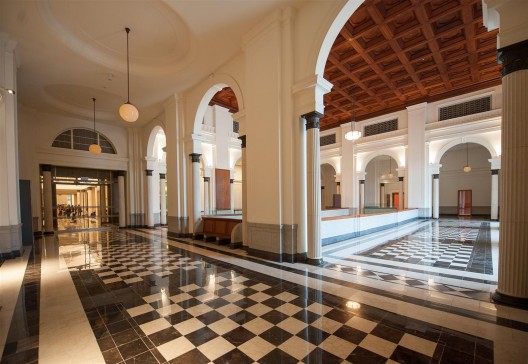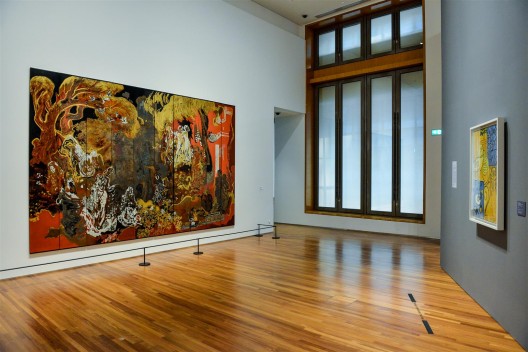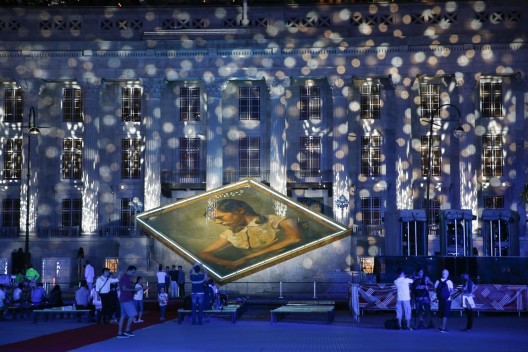Like the impact of any massive object, the past months have seen shockwaves emanate from the opening of the National Gallery of Singapore (NGS), in the form of various reviews and opinion pieces. With some time having passed since the initial weeks of a carnivalesque cavalcade of opening celebrations, now seems a fitting time to take soundings of these varied reactions.
One of the most remarked upon is “Singapore’s New National Gallery Dubiously Rewrites Southeast Asian Art History” by the critic Bharti Lalwani, published by Hyperallergic. Within Singapore’s art community, this charged headline spread like wildfire. Responses to her text were varied, including outright hostility, bemused derision, and faint, guarded praise. In this age of social media, special mention must be given to various shares and re-posts which appeared to laud the author as a lone voice in the darkness, speaking truth to power.
It goes without saying that an institution on the scale of the NGS wields considerable power, and that its exercise ought to be scrutinized, critiqued, and challenged to guard against the abuse of said power. This impulse is only strengthened when one factors in the context of it being a Singaporean institution: Singapore, which subordinates freedom of expression and of the press to the needs of “nation-building,” with its history of single-party rule and its regional role as a hub of financial secrecy. In case the past sixteen years of high-profile investment into the arts (with the half-billion dollar cherry of the NGS on top) prompts the thought that those were just the bad old days, consider a government official’s recent remark that art which depicts Singapore’s public institutions “in a bad light or puts them in a derogatory position” may be ineligible for public funding.
However, Bharti Lalwani’s article does not so much speak truth to power as gesticulate in its general direction. What insight it offers is overshadowed by a number of peculiarities—for one, her laser focus on press preview minutiae such as the banal brevity of PowerPoint presentations, Lalwani’s conversations with various notable figures and the press preview’s apparently off-putting failure to highlight the genius of studio Milou architect Jean Francois Milou, previously the subject of a fawning interview by Lalwani.
In one section of “Between Declarations and Dreams”, Lalwani wonders if Raden Saleh, Juan Luna, and Felix Resurreccion Hidalgo were aware of one another, their respective works, and the social and aesthetic frameworks in which they worked, and asks after explanatory texts to compare the details of these paintings. Such questions would seem to imply that the gallery had gathered similar 19th century paintings and left them to their own devices—and not, say, drawn together a number of illustrative examples of the utilization of European conventions of painting and representation and its attendant anxieties and intricate power-plays.
These first few segments of the exhibition offer a fascinating look at the various transitions of the colonized peoples of the region from those depicted by the colonizers, to the colonized peoples’ own representations, and the signals and uses these hoped to achieve. Of special note is the first room, the former courtroom of the Chief Justice, in which early colonial representations of Southeast Asians—as if they were ethnographic specimens to be catalogued—are displayed in a setting which exudes power: an elevated judge’s seat framed by a lit proscenium, the whole tableau overlooked by state portraits of royalty.
Throughout the exhibition, at every point at which a lack of context is claimed, the converse is true. Instead, the art history of the region is neatly compartmentalized and relentlessly explained to an extent that seems, to my eye, bullishly over-determined in its didacticism—safe and sane to a fault. With such an abundance of contextualizing information, how then to reconcile these differing accounts of reality?
In essence, context is supplied crafting a narrative which connects these artworks, but it is not the context that Lalwani would have, nor the narrative she wants: an elementary primer on post colonialism in Southeast Asia. In the face of this surplus of information, her calls for more suggest a yearning for something akin to the therapeutic didacticism of Alain de Botton’s Art is Therapy, which helpfully suggested how viewers might react to each painting in a museum. Taking the National Gallery’s very first permanent exhibitions to task for being rather general in scope is akin to decrying the dullness of a building’s foundations.
More egregiously, whilst admonishing the National Gallery for committing an error of fact concerning the date of Redza Piyadasa’s “May 13, 1969,” Lalwani describes the work as “referencing” racial tensions in Malaysia and Singapore in that same year. She also suggests that it should have been displayed in connection with Jim Supangkat’s “Ken Dedes,” and FX Harsono’s “Paling Top,” given that Supangkat and Harsono “similarly break from formal divisions between painting and sculpture to critique pervasive corruption.”
Never mind that “May 13, 1969″ does not reference generalized “racial tensions” in Malaysia and Singapore, but constitutes a specific response to the 13 May Incident which saw (with some reports of official complicity) hundreds dead, as well as the resignation of Malaysia’s first Prime Minister, a state of emergency lasting 18 months, following which the racially aligned New Economic Policy emerged.
Never mind that Jim Supangkat’s “Ken Dedes” made tangible the conflict and collision between two very different representational cultures, meshing the classical statuary of the Javanese Queen Dedes with an illustration of a topless, bush-baring, denim-clad woman. Never mind that FX Harsono’s “Paling Top” responded to Suharto’s New Order depoliticizing art, and the prevailing Indonesian view of art as the artist’s “soul made visible,” by producing a readymade which critiqued the New Order’s “out of the barrel of a gun” approach to politics.
Apparently, as pioneering artists in Southeast Asia not working in traditional media who engaged with a wide range of issues which could be gathered under the generously broad subject of “corruption,” they ought to be lumped together. It’s an approach which sounds a lot like the one the writer claims to have been used with the paintings of Raden Saleh, Juan Luna, and Felix Resurreccion Hidalgo.
Even more bizarrely, Lalwani describes the National Gallery as “owned by the Singapore authorities, [but] privately run, which means the curatorial mandate is independent of possible government interference.”
Without getting into the minutiae of how the National Gallery and the government of Singapore are intertwined[1], it’s certainly possible that its curators are wholly insulated from any (censorious or otherwise) demands by Singapore’s government. However, one could hardly be faulted for cautiously assuming some degree of influence, particularly when one considers the nigh-invisible forms that influence can take, the public/private distinction seeming practically perfunctory in the 21st century.
Some other strange assertions remain: for instance, that the existence of these exhibitions somehow rewrites the established corpus of Singaporean and Southeast Asian art history—and that the very practice of “history-writing” is in its infancy, a comment which drew much derision from those in the field. Or that the expenditure of half a billion dollars somehow purchases for Singapore cultural hegemony over the region. One wonders if similar sums spent on the inaugural Youth Olympics, or over a billion dollars on the Singapore Sports Hub, have garnered Singapore some corresponding sporting hegemony.[2]
As for the gallery’s subsequent presentations, which involve working with Tate Britain and the Centre Pompidou, Lalwani’s purchase-oriented theme continues. Regardless of any possible implications of moving so quickly to partner with such old-established European institutions, it’s still startling to see “Reframing Modernism” and “Artist and Empire” accused of being “pre-curated blockbusters” purchased by the National Gallery.
Whatever their particular merits or failings as exhibitions, they do appear to involve curatorial contributions from all the institutions involved. There’s also the assumption that these exhibitions will revise the stories of the region to foreground Singapore’s part in them. This is a bit odd if, as she claimed, the curatorial mandate was free of governmental interference, and would also imply the support of the Tate Britain and Centre Pompidou in some jingoistic chest-thumping.
All vituperation aside, Lalwani’s article is not without useful insights—there is, for instance, a brief mention of the startling number of restaurants and cafes at the National Gallery, including the cringe-inducingly named “National Kitchen.” In far outstripping a major museum or gallery’s usual complement of a bookstore, a cafe, and possibly a restaurant, the National Gallery’s eight restaurants and one shop seem egregious. Is it plain revenue generation, pandering to the tastes of the leisure class, or that unshakeable Singaporean conviction that anything, even a subway system, can be improved by partially converting it into a shopping mall?[3]
A more measured dose of criticism can be found in an article penned by the Singaporean artist-activist Woon Tien Wei. Published on The Online Citizen, one of the few independent counterbalances to mainstream media in Singapore, Woon scrupulously avoids the tangled verbiage of International Art English; curiously, these simply phrased criticisms resound more forcefully in plain language.
By way of an introduction, Woon summarizes the years leading up to the opening of the National Gallery—basically, the ten years which passed from the inception of the idea for the National Gallery to its eventual completion did not pass altogether smoothly. Woon mentions the project taking twice as long as initially planned, having been plagued by staff reshuffles and name changes long before it ever opened its doors, and a tragic accident which killed two and injured three workers involved in its construction. It’s striking to note that mention of these troubles were generally absent from a flurry of articles which marked the gallery’s opening.
While Lalwani’s article generally reads like a chronicle of a press preview and the exclusive access such an event allows, Woon’s article comes to us from exploring the gallery during one of the interminably glitzy events which signaled its opening, relaying both his own observations and interactions with general visitors to the gallery. For instance, concerning Chia Mia Tee’s “Epic Poem of Malaya”, Lalwani relates an explanation supplied by the poet-author Alvin Pang, while Woon reports on an unnamed woman informing her daughter that the singlets and ponytails worn by the figures in the painting indicate their communist affiliation.
Another of Woon’s revealing—if somewhat depressing—observations concerns the number of people who saw no objections to getting grabby with the artworks on display. Evidently the National Gallery has an uphill task ahead in encouraging visitors not to prod century-old paintings; but the gallery appears game—one of its goals is to partner with a local university in offering an undergraduate degree in art history.
As for the permanent exhibitions themselves, Woon takes a fairly broad view of the shows and generally avoids delving into the specifics of given works. Concerning “Siapa Nama Kamu”, he observes—despite the Malay title—the absence of Malay artists in the exhibition’s flyer, as well as the overall lack of anything particularly related to Malay culture in the exhibition’s overarching themes.
This distance from the exhibitions themselves might frustrate some readers, with frankly opaque and not terribly informative sentences like, “This exhibition has a stronger curatorial framework and the spacing between the works is generally better than ‘Siapa Nama Kamu,’” without much by way of discussing how the curatorial frameworks differ between the two exhibitions. Evidently, the focus of this article is less the exhibitions proper, and more the arrival of the National Gallery as whole.
A more exhibition-focused bit of criticism can be found in a review by Mark Rappolt in Art Review, which nevertheless opens with some contextualizing which might seem like a bland filler to those familiar with Singapore, but will probably be of use to the vast number of people from whom Singapore is “that clean rich place that libertarians occasionally fantasize about for some reason.” Singapore’s official languages, age, and single-party rule are reiterated, along with the handy fact that the Japanese surrender in 1945 was signed in one of the gallery’s constituent buildings.
Prefacing Rappolt’s comments on the exhibitions proper is his observation that the National Gallery memorializes its former functions almost as much as it does the art within, a state of duality which occasionally leads to frank confusion. While Singapore is no stranger to recycling old buildings to use as art spaces—The Substation’s former use should be self-explanatory, while the Singapore Art Museum occupies the former campuses of Saint Joseph’s Institution and the Catholic High School—the former functions of these structures are generally relegated to a footnote. This confusion of purpose might well be borne out by the National Gallery’s upcoming Constitutional Gallery, slated to open in August of this year, which is set to display constitutional documents. It’s a project that might be better suited to the National Archives or the National Museum of Singapore (the latter has also occasionally made some curious programming choices over the years, such as “The Art of Cartier” in 2006.)
In discussing “Between Declarations and Dreams”, Rappolt goes on to discuss his unease with a possible signal being sent by the exhibition—that art began in the region, in the modern sense, with two dimensional works in the Western tradition, and the possibility for exclusion that such a reading could produce. More generously, he suggests that the exhibition could instead be read as an infiltration by regional artists into the Western tradition which they subsequently subverted and repurposed to their own ends, just as City Hall and the Supreme Court were repurposed as the National Gallery—an idea which is lent an additional degree of depth when one considers his mention of the somewhat split personality of the National Gallery, which is sometimes National first, and sometimes Gallery first.
Another of Rappolt’s comments on Siapa Nama Kamu stands out; he describes the display of contemporary performance relics as “slightly patchy,” which calls to mind the unofficial line of demarcation between the purviews of the National Gallery and the Singapore Art Museum. The popular understanding is that the focus of the National Gallery is the modern while the Singapore Art Museum concerns itself with the contemporary—but how can that distinction be made clear, especially to a public which imagines the two to be one and the same? Based on a number of conversations (the precise year varies from source to source) there is a line drawn, at some point in the 1990s, cleaving the concerns of one institution from the other. On either side of it, each institution has free rein; when they wish to cross that line, a conversation ensues. The problem implicit in such an arrangement lies in exhibitions, such as “Siapa Nama Kamu”, which sit astride that administrative distinction. Could demarcatory issues have played a part in what Rappolt sees as the patchiness of the performance relics on display?
With less than half a year under its belt, it’s still early days for the National Gallery, but there’s no shortage of observers and commentators watching its moves and debating the significance of its programming decisions. Of course, as the new kid on the block with very deep pockets, such scrutiny is not only welcome, but necessary—unless it tilts at windmills, rather than giants, that is.
[1]Based on the FY2014 Annual Report, the National Gallery is a public company limited by guarantee, registered as a charity and an institute of public character, whose members are Singapore’s Ambassador at Large, the Permanent Secretary of the Ministry of Culture, Community, and Youth (MCCY), and the founder of DP Architects. The board of directors is mandated to have a representative of the MCCY. Its ingoing cash-flow is largely split between government grants and private donations, with the National Gallery Singapore Development Fund (a trust fund held by NGS on behalf of the MCCY) being of particular interest.
Of its five Founding Partners, three are government-linked companies, with controlling interests held by the state’s investment company, Temasek Holdings. The initial funds which enabled construction of the gallery were donated by the Tote Board, a statutory board of the Ministry of Finance.
[2] On a lighter note, consider this article, which manages the stunning feat of a) not noticing any Singaporean art in the National Gallery, and b) transitioning from the passive to active voice within the space of a single sentence.
[3] By my own crude analysis of the maps of the National Gallery, the ratio of exhibition to restaurant/retail space is about 3 or 4 to 1.
